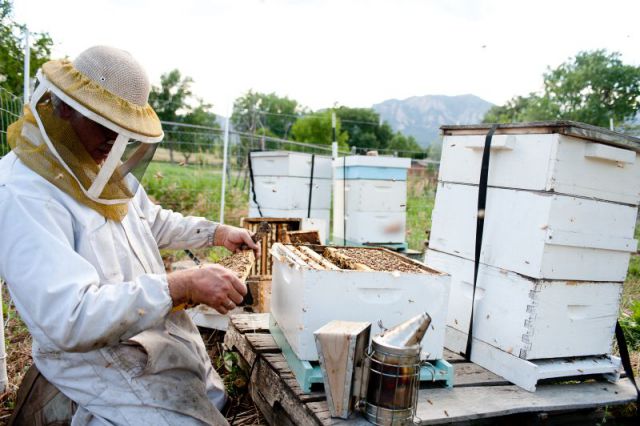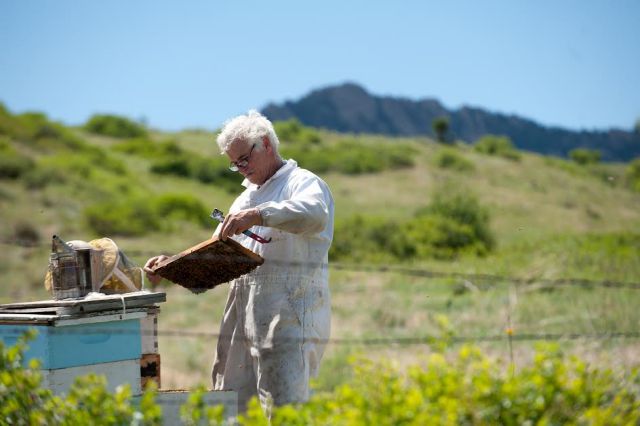When it comes to insects, bees are a top contender for MVP.
They’re hard workers, key players in the ecosystem, and serious pollinators; they transform nectar into a substance so divine it’s apparently been collected by humans for at least 8,000 years.
Honey contains vitamins, amino acids, minerals, and immunity-building antioxidants. It’s also naturally delicious.
As a lover of honey and an aspiring beekeeper, I’d been feeling a little flummoxed about how best to support these beautiful bees and how to buy honey responsibly and from the best sources. So I recruited Tim Brod, owner of Highland Honey Bees, to help me get my head on straight. Over herbal tea with plenty of honey and a shot of homemade moonshine, Tim and I talked bee business at his honey-processing headquarters in Longmont, Colorado.
The Journey of a Beekeeper
“I was one of those kids whose greatest joy was to be outdoors. I grew up with a love of people and a love of animals and a love of the interactions between them. I loved looking at systems,” says Tim, whose connection to bees began with his grandfather’s brother Crozier, in semirural Connecticut, where Tim grew up in the 1960s. Apparently beekeeping was easier back then. Tim explains, “Until 20 years ago, you really didn’t have to do much for bees. The world was a lot different then. Survival strategies of bee colonies that worked for millions of years haven’t worked for the past 15.”
Tim’s historical perspective on bees goes back decades. In the 1970s, Tim left the US and lived abroad for nearly 10 years, primarily in the Middle East and North Africa. During this time, he expanded his beekeeping knowledge, learning more about the art and science of beekeeping. For example, Tim explains, “Egypt has some of the longest-documented history of working with bees of any place in the world. There are signs in the tombs of beekeeping practices.”
Tim wasn’t exclusively busy with bees while living abroad. He also worked in other agricultural pursuits, and as a commercial diver doing salvage work in the Suez Canal, removing sunken ships, airplanes, and tanks (yes he did!). He headed back to the States in the 1980s and finished a degree in anthropology and marine biology before continuing his work with bees and other biological systems in northern California.

Tim Brod’s Millions of Bees
It was the current pollinator decline, paired with his passion for and connection to bees, that inspired Tim to open Highland Honey Bees in 2008. He shares, “I guess the main pull was that I knew all our lives are made better by having bees around. To see them, what they do, to watch them and how they work. What they contribute is overwhelmingly wonderful.”
Despite now keeping millions of bees in several hundred hives on land throughout the Front Range of Colorado, and gathering about 10,000 pounds of honey each year, Tim is concerned that there isn’t sufficient forage (bee food) in places like Boulder County to sustain his business. According to Tim, it’s “a combination of agricultural practices, urban land-use practices, more housing developments with grass lawns and no forage, and more well-intentioned hobbyist beekeepers unintentionally spreading disease” that informs his concern.
Real Honey is Like Handcrafted Beer
Tim believes that very few people have eaten “real honey.” He says, “For me, real honey means it has not been altered in any way—no heat whatsoever and no filtration.” It also means the honey tastes better; Tim uses a beer analogy to make his point: “Once you taste it, you’ll know. There’s not any ambiguity. You can have a Coors Light and you can have a local handcrafted beer, and when you taste them, with few exceptions, you do not mistake the two of them.”
Taste and purity aside, cooked honey doesn’t offer the same health benefits as pollen-packed raw honey. Tim isn’t suggesting we trash all the honey in our kitchen because it’s been altered with heat or filtration. There’s room for both types, especially if you’re cooking with it. Nonetheless, Tim hopes these six truths about honey prove to be helpful and interesting.
Six Truths about Honey that Tim Brod Wants Everyone to Know:
1. Raw should actually mean raw.
Unfortunately, that’s rarely the case. Here’s a fun fact for raw-honey lovers: There’s no official US federal definition of raw honey. Tim believes honey that’s been heated above the temperature of a hive, which is about 95° F, should not be called “raw.” The bad news is, many companies label their honey raw anyway, and it’s impossible for consumers to tell the difference.
2. Crystals in honey don’t mean it’s gone bad.
One of the reasons processors heat their honey above the hive temperature is to prevent crystallization. Though honey with crystals is just as delicious and healthy as honey without, Americans tend to prefer liquid viscous honey. Tim explains that crystallization occurs naturally in all raw honey (with very few exceptions), and it doesn’t mean the honey has somehow “gone bad.” If honey is purchased without crystals and doesn’t ever crystalize, it’s a red flag that the product has likely been altered in some way.
3. Quality isn’t the driver of common processing practices.
Commercial honey processing was designed with efficiency in mind, not quality. Another reason honey is heated is to allow the beeswax to rise to the surface quickly, making it easier to remove the wax, and more quickly pump the final product into containers. Here’s Tim’s take: “If I heated honey above 95 degrees and put it under pressure, could I fill jars of honey faster than one every six seconds? Yes. Do I need to fill one faster than one every six seconds? Not in my worldview.”
4. Labeling laws? What labeling laws?
When it comes to labeling laws, Tim asks, “What do ‘raw,’ ‘local,’ and ‘unfiltered’ actually mean? Should a company that packages in your state but sources honey from all over the world be able to call their honey ‘local’?” To say that Tim doesn’t trust the labels on honey jars would be an understatement. He’s also adamant that there’s little to no oversight or regulation. From his perspective, it’s up to all of us to start talking to our grocery stores and demanding accuracy and transparency in honey labeling.
5. Honey that’s been heated tastes different.
One of the many reasons Tim is a proponent of eating truly raw honey is pretty simple: it tastes better. He explains that when you heat honey, you “alter the chemistry of the honey and you off-gas all the aromatics that give honey its unique flavors, the rich floral taste. Heating honey in any way will destroy the taste component.” He offers a great tip: “If you smell a beehive and you smell bees and you smell honey, guess what? They should all smell the same. If you open up a jar of honey and it’s got no smell, you should be suspicious.”
6. Pollen is good stuff.
Remember how Americans tend not to like crystals in their honey? Well, one cause of those crystals is pollen, so honey processors will often remove (filter out) the pollen in their effort to eliminate crystallization. Tim explains this process, “The American Honey Board says you can mix honey with diatomaceous earth, which results in an ionic action that attracts the pollen and pulls it out. The diatomaceous earth stays separate and is filtered out under heat and pressure and this process keeps the honey from crystalizing.”Here’s the problem: “When the pollen is removed, it becomes impossible to trace the honey back to its source, and you miss out on any of the health benefits of pollen,” explains Tim.
The health benefits he mentions are significant. You may not know that pollen is one of nature’s most complete foods. It contains more protein than any animal source, half of which is in the form of free amino acids, meaning it can be readily and directly used by the body.
Now that we have a better idea of the honey options on the market, let’s focus on the fact that the future of great honey is at risk. Bee populations are declining, which is problematic not only because it reduces honey amounts but because bees are powerful pollinators to the great benefit of humans, plants, and the earth. What can we each do to support healthy bees? Below are a few simple tips from Tim.
Start Supporting Healthy Bees Today with Four Simple Tips:
Tip #1: Plant forage
Bees need nectar, which is found in flowers and many types of flowering shrubs. This is convenient, because flowers are beautiful and make people happy! However, not all plants are created equal when it comes to attracting and nourishing bees. Before you start digging, check out these lists of bee-friendly plants or contact your local beekeeping association for advice. Tim says anything in the mint family is a great place to start because these plants are high-nectar producers that are super easy to grow. He explains that using your “little 2-foot-by-2-foot area, or 10-foot-by-10-foot area, or 20-by-30-foot area to put in habitat or forage” is a great entry point into becoming a bee champion.
We can also do our best to promote and protect the forage in our community by lobbying our municipalities to plant more nectar-producing flowers and let wildflowers bloom in the road medians. Tim says that ideally, “we want things to be blooming from late winter to first frost” to keep the bees happy and well fed.
Tip #2: Ditch the pesticides for good
“We’ve had 40 years of marketing to convince us that a lawn should not have a goddamn dandelion on it,” decries Tim. How does a lawn end up with no dandelions? With the help of a fervent weeder or, more likely, pesticides. People use these dangerous chemicals prophylactically in farms, parks, and in their own yards not realizing, or simply ignoring, that these chemicals are bad news for many living things. Bees and pesticides are not buddies, plain and simple.
Tip #3: Plant up your lawn
Tidy, sprawling carpets of lawn do not attract bees. As a lawn alternative, Tim suggests creating a bee habitat. This can be a tough pill to swallow because most of us are ingrained with the idea that a well-groomed lawn is attractive, appropriate, and even a status symbol (true confession: I haven’t quite yanked up all my lawn yet because my son loves playing on it). If that conditioning is too hard to crack, or your homeowner’s association doesn’t share Tim’s view, even adding a simple flower boarder to your Kentucky bluegrass is helpful.
Tip #4: Buy good honey
To find honey that has not been heated and is still chock-full of pollen, Tim suggests contacting your local beekeeping organization to get a list of beekeepers who will sell their honey to you directly. These small producers are far less likely to heat or alter their honey. That’s great advice, but in some places and for some people, the process of tracking down pristine honey sounds daunting and time-consuming. What if I want to buy my honey from the store? Tim laments, “It’s very hard!”He explains that, unfortunately, most grocery store workers are equally stumped when it comes to figuring out which honey products are raw and local “because almost every label says raw and local.” What a bummer! This is where Tim’s passion for improving the honey-labeling laws to increase transparency starts to become contagious.
If we step out of the honey pot for a moment and look at the big picture, Tim is making a compelling argument for the power of a robust local food system. When you know your farmers and producers, transparency is unavoidable.
Tim wraps up our chat with a (wise) call to action:
“It’s really essential for everyone to get in the game. Bee loss and pollinators are too important for us to just remain numb and inured. You can’t stay at home by yourself with your satellite and your cable and your iPads and just ignore the fact that there’s such a lack of sustainability. Get involved, be engaged, and make one choice every day to make things a little bit different.”

Make Your Own Bee Well Honey!
There are so many ways to use honey, but one fun option is to infuse it with herbs. You can get in touch with Tim about the numerous herb-infused honeys he sells, or you can buy some raw honey and infuse it with herbs yourself. If you think you’re ready to roll up your sleeves and do a bit of hatching, check out the recipe below from Hatch Lab’s friend and herbalist extraordinaire Faith Rodgers of The Little Herbal. Faith recommends taking the honey directly by the spoonful or adding it to warm water or tea to boost the immune system and fight colds and flu.
Ingredients:
• 6 ounces raw honey (by volume)
• 1 tablespoon dried ginger
• 1 tablespoon cinnamon
• 1 tablespoon dried elderberries
• 1 tablespoon dried thyme
Instructions
- Mill your herbs to a coarse powder using a coffee grinder. You don’t want the powder to be too fine or it will be hard to strain the herbs out when the infusion process is complete.
- Add 6 ounces raw honey to a clean 8-ounce canning jar.
- Add powdered herbs to the honey, mix well, and secure the lid.
- Place the jar in a sunny window and allow for a 2- to 4-week infusion process. Flip the jar periodically to mix the herbs and honey.
- After 2 to 4 weeks, make a water bath on your stove by adding room-temperature water to a saucepan. Place the jar in the water bath, turn the burner to low, and gently warm the honey to achieve a pourable consistency. Be sure to keep the honey below 95° F to retain its beneficial properties.
- Remove the jar from the water bath once the honey is pourable, and gently dry the outside of the jar.
- Strain the honey through cheesecloth or a fine metal strainer to remove the herbs. Compost the spent herbs if possible.
- Store in a clean glass jar.
*An earlier version of this article was posted at Hatch Lab (Eds: Joy Herbers & Maggie Wells)
_________________________________________________________________
Bonus video: Waylon talks with two experts about how *you* can save the bees this Holiday season
Bonus video: Interview with Tim Brod of Highland Honey
Author: Mara Rose
Editor: Renée Picard
Images: Courtesy of Highland Honey Bees & Shutterstock (via the author)












Read 4 comments and reply